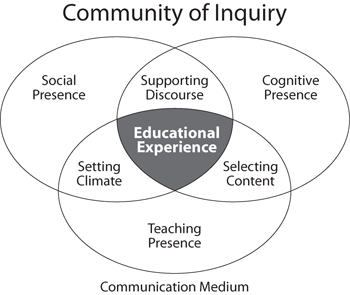Continuing on this trip in the world of modern pedagogy in times when you have to adapt and adjust yourself to the new digital environment, we “bumped” into the community of inquiry (CoI) framework during the ONL course. Since I had never heard of it before and I got interested and wanted to look into it. What does it really mean? What are we talking about?
CoI refers to Garrison, Anderson and Archer’s (2000) model for online learning. They think that meaningful learning can occur when teachers and students form a community of inquiry. The community is based on interaction between students and teachers and can be divided into three (or four) components or presences: 1) social presence (that might include emotional presence or not), 2) cognitive presence and 3) teaching presence.

We dug further into the concept of the different presences and as i was reading about social presence I found that there are a lot of similarities between building trust in my present job as a clinical psychologist and what was presented in the COI theory (setting climate and supporting discourse). The difficult question is how to build an environment that will make people want to work together in a way that matters and will have an effect on their thinking or feeling.
One aspect of social presence was also the ability of people to present themselves as real people. That is the ability to be authentic and true. Some results also indicated that when you feel secure enough to be yourself, you also learn more and you gain more. So working with students, one of the most important thing is to make the student feel secure and safe, so the student can trust you and trust that the collaboration will work and lead somewhere. In the long run we would like to perhaps feel better, resolve some issues, be able to reveal our actual feelings and thoughts about ourselves and our situation, be more creative and open.
Of course there are some differences between these to worlds. In educational surroundings, online or offline, it is okay to be personal but maybe not private when working together and building a good, social environment. In a psychological or clinical world it is absolutely okay to be personal and private, at least for the student. But the feeling of safety will in both worlds make you relax, it will help you think outside the box, it will help you to try on new things and make mistakes without feeling too bad or devastated. In the best of worlds it also will make you accept yourself and others, whatever it means.
But building this kind of environment takes time. To build the trust, respectfully and without pressure we need to plan and sacrifice enough time in the beginning of the relationship, the groupwork or course. Maybe it does not feel necessary but it will pay off. We do not have a lot of time, not in education and unfortunately not in clinical work. We always have too much work and too many projects going on. We do not take time to chit-chat or to tell personal or funny stories to get to know each other (as colleagues, teachers, counsellors). We are often too busy with content and achieving. I think content is important but I think we need to focus a bit more on context to prepare our students for the content.
Social presence will do just that, in a respectful, inspiring and loving way.